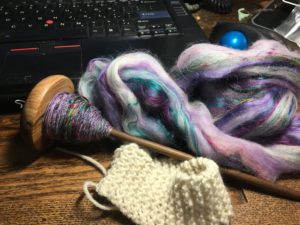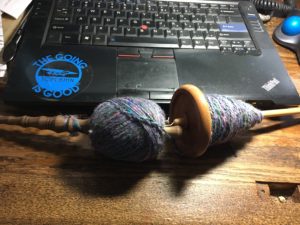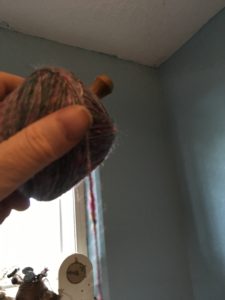UPDATED:
Right now, there are a lot of folks at Ravelry, trying to download patterns they purchased. And many seem to be saying, “What was I thinking?” So here’s a little story to go with that. This is Inglenook Fiber’s Violet Teacup.
I like their fiber and have spun several different blends. This one is merino, silk and sari silk. Let me say, up front, this is nice fiber and there’s nothing at all wrong with it!
I hadn’t been participating much at the Jenkins forum. They decided to have a Mad Hatter Spin Along. It sounded like fun. I saw this fiber and thought it would fit the theme, so I ordered it. I also ordered some of their Obsidian colorway. When I ordered this, I didn’t ask some critical questions. Is this a fiber I like to spin? What are my plans for the yarn? Is a Jenkins spindle the best choice here? I started spinning with the group and quickly ran into trouble. I did not like spinning this at all. In fact, I started randomly picking up other fibers and spinning those instead. I tried a few different Jenkins turks, but couldn’t find a good match. I even tried peeling off some of the silk but it didn’t help. It was not fun. I resigned myself to the fact that I was not going to complete this one. Then I tried some of my Hatchtown high whorls. I still didn’t like spinning it. I just sat it aside and figured I’d deal with it some day.
I got the notion today to try spinning it on my Bosworth butternut skinny midi. I really like this spindle and think I can spin almost anything on it. While this will never be my favorite fiber, I can actually spin it. And I’m spinning finer than I was on the other spindles. So yeah me! I may actually finish the two ounces of this. I still have no idea what I’ll do with the yarn.
No one twisted my arm to buy the fiber or participate. I know that I don’t like merino and that clumps of silk in a blend can cause problems drafting. But I also know that I wouldn’t have even thought about this fiber, if I hadn’t been on that forum. I was focused on what the group was doing and was interested in, not on what I like to do. And that has happened to folks that bought patterns. They may have heard about something on a forum or seen it in a pattern search. They probably didn’t take the time to ask those important questions. They just bought another pattern. Now, because downloading the purchased patterns is so time consuming, they are having to decide if they spent their money on something they want to make. Some are deciding that they have enough patterns to last for a long time. Escape from Ravelry seems to be encouraging people to use the patterns, fiber and yarns that they have and most importantly, to use their own creativity for a change. I think you are going to see some truly wonderful things created during this time. But you won’t see them on Ravelry. We’re already gone.
UPDATE: I was thinking about this and the SAL was actually in the Spinning Circle group, not the Jenkins group. So not as restrictive as to equipment, as long as it was done on a spindle. I finished spinning the fiber yesterday. Am plying it today.
Picture of the spindle I’m plying with and my plying stick:
And here’s the plying stick in action, so that you can see how easy it is to control the twist at the end:



Teri, you are spot on with that observation. I have stash enough to last what I hope will be this lifetime; why buy more? Ditto for patterns: I could outfit a dozen other knitters with what I have kitted up just waiting its turn on the needles.
I’ve said it many times before, but I’ll say it again:
“Bless those who disappoint you; they’re leading you toward a better path.”
My excuse was that I’d packed my fiber stash and couldn’t find it. But then I found the trunk that it was packed in. I still bought fiber 🙂
Part of it is that we want to participate in a group. It’s fun to see what others come up with. And sometimes it can be motivating. Other times, it’s like this project. It took time and money away from things that I would have enjoyed more. And I’ve wasted time on patterns that were wrong for me, poorly written, or problematic. I’m less inclined to tackle something that doesn’t interest me, when I’m working on my own.
Grouping up is a survival strategy every healthy organism–even at the cellular level–employs. And after grouping comes establishing hierarchies, a fundamental biological strategy inherent in all complex organisms.
So, we’re just “going with the flow.” 😎